
What's New
Home > What's New > Information
Information
News
Posted on March 29, 2005 @ 03:06 pm
APC Filtration Inc., an OEM supplier of filters and filter bags to industrial, commercial and domestic floor care appliance manufacturers has acquired the worldwide rights to manufacture HEPA Membrane Vacuum Cleaner Filters and Bags made with DuPont Teflon membrane. APC began manufacturing Teflon filter products in Canada and China in January 2004 and is currently expanding both operations. APC is also developing Dupont branded non-membrane filters for HVAC retail sales in late 2005.
The first product offered under the agreement with DuPont, manufacturer of Teflon branded coatings, is a series of nonwoven filter bags for OEM?s of industrial, commercial and domestic central vacuum cleaners. In the second quarter of 2004 the company started full-scale production of disposable HEPA membrane bag filters for industrial, commercial and domestic vacuum cleaners.
Index Draws Largest Crowd Ever
 |
The results are in. INDEX 2005 was the largest ever. Held April 12-15, 2005 at Palexpo in Geneva, Switzerland, INDEX visitors increased by 7.5% compared to INDEX 02, to just over 12,000 visitors. The geographical reach of the exhibition increased to attract visitors from 107 different countries worldwide.INDEX 05 was the largest edition ever in size as well with 21,200 square meters of net stand space, occupying 50,000 square meters of exhibition hall.At INDEX 05, 470 exhibitors from 36 different countries from around the world were present showing all the latest developments in the nonwovens industry and representing all sectors of the nonwovens value chain.Showing the continued diversification of nonwovens, twice as many visitors said their company was involved in the automotive sector than in 2002, demonstrating the buoyancy of nonwovens in this particular sector. Additionally, organizers saw an increase from around 6% to almost 9% in both gas and liquid filtration sectors. Number of visitors operating in the construction field increased by an impressive 39%. The percentage of visitors active in the agriculture and horticulture sectors almost doubled from 5% to 9.5%.However there remains a firm bedrock of visitors also present in the traditional sectors of hygiene and medical.As expected, all the other targeted sectors such as carpeting, geotextiles, composites, electronics, fuel cell, home furnishing, cleaning and wiping, interlinings, nanotechnology, packaging, printing, protective wear, leather goods, technical textiles and others were very well represented.These diverse visitors were treated to a detailed look at the nonwovens industry with exhbitors ranging from roll goods producers to raw material providers to machinery and equipment products as well as commission converters, organization and educational facilities.
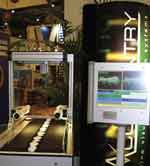  |
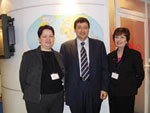 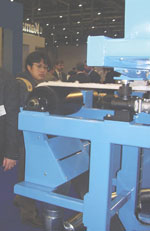 |
 |
| Clockwise from top left: Accusentry showcased a hygiene product inspection line at INDEX; Ahlstrom's Karen Renton, Claudio Ermondi and Ellen Miles; business is conducted at Ciba's booth; A visitor checks out Dan-Web's latest webforming technology; a crowd gathers at Clopay's booth. | ||
Bayteks Nonwovens working on a 2.4-meter spunwoven line for the bedding industry. The existing 3.2-meter line has traditionally served the furniture market, but the 2.4-meter option will allow the production of products such as duvets. This development is in response to numerous requests from the industry, according to the company. It is due to be available in the third quarter of this year.
Advanced Fabrics (SAAF) announced at INDEX that it will install a multi-beam Reicofil 4 machine at its plant in Saudi Arabia which is due start up next year. The investment will increase SAAF's capacity by 30,000 tons per year. SAAF also announced the recent startup of a medical treatment plant on the same site.
The company also introduced Medalon, its new product designed to provide surgeons and other operating room staff with "the ultimate in protection and comfort."
N-MBR is a nonwoven-based membrane bioreactor for wastewater and effluent applications, developed by KNH, to give a high solid-liquid separation, which allows a conventional system to run at a high MLSS level with as little as a third of the reaction space requirement and minimized fouling at equal effluent loading. N-MBR is designed for high specific permeate flux at low trans-membrane pressure. It offers high sludge retention capability, ensures low suspended solid levels in effluent and minimizes the need for backwash.
Also new from KNH is BioWEB-a nonwoven biomass carrier, which features high porosity and high specific surface area. KNH says it displays good micro-organism compatibility, high suspended solid retention capacity and good compression resistance. Typical applications are wastewater and polluted water treatment, plus tertiary treatment. BioWEB is designed to enhance removal of dissolved organics and nitrogenous pollutants, such as ammonia and nitrate, in a conventional bioreaction system. It can be used in conjunction with N-MBR.
Teksis has developed new wipes for household and industrial uses. Teksis also brought out a fire barrier for mattresses and furniture, which has passed TB 603 in the U.S. and Crib 5 in the U.K. The product is antidusting and said to be easy to cut and quilt. In addition, Teksis introduced recycled cotton felts for applications across a number of industries.
Raw Materials Producers Show Their Stuff
Aplix brought out two new hooks and a landing zone. The Aplix 731 is a 400 mm-wide molded tape designed for softness and flexibility, with a high density of micro-hook gripping elements in the cross direction. It can be used with all types of landing zones. Customized colors are possible, as is a hookless zone. Target peel strength is 5-8 N and dynamic shear, 40-60 N.
Also on display was Aplix 946, a 400 mm-wide molded tape which features a high density of micro mushroom gripping elements. Designed for use with all types of landing zones, it can be specified in customized colors and with a hookless zone. Target peel strength is 4-5 N and target dynamic shear, 40-50 N.
The new landing zone, Aplix BW5.0, is a nonwoven designed to have a much softer appearance and touch than knitted alternatives.
BASF has engineered a new climate control material, which received its first INDEX airing. Luquafleece IS, a fabric superabsorbent, can absorb more than 100 grams of moisture per square meter (depending on the polymer loading). Luquafleece IS combines the strong absorption capacity of highly functional superabsorbent polymers and a nonwoven. It consists of a high molecular weight, lightly crosslinked and part-neutralized polyacrylate polymer, which is applied to a polyester nonwoven. BASF says the use of Luquafleece IS in chairs, car seats and mattresses leads to long-term comfort and stability with a "unique wellness feel". It also offers humidity control for packaging. There is no powder shake out and no dust generation, according to BASF, because the SAP is fully bound the Luquafleece IS. The result is a more homogeneous SAP loading.
In other BASF news, for the first time, the company's Technical Applications group was at the show, with the specific task of looking at new markets for BASF's innovations. The focus is to provide new solutions to common problems, according to BASF.
Birla Cellulose commissioned a new cellulose line in Indonesia last year and intends to bring another on-line in December this year. Both lines are designed for production of around 100 tons/day.
Celanese Emulsions was at the show for the first time at INDEX after it being formed in February through the merger of Celanese Europe and Vinamul Polymers, the former polymers business of National Starch & Chemical. The main product offering from Celanese Emulsions is emulsion polymers and polyvinyl alcohol for nonwoven bonding and functional treatment.
Ciba Specialty Chemicals introduced a polymer modifier for polyolefin nonwovens. Irgatec CR allows nonwovens producers to use standard polypropylene spunbond grades or recycled granules from fiber scrap to design meltblown nonwovens with what Ciba describes as outstanding barrier and mechanical properties. Irgatec CR is billed as a breakthrough in quality improvement for hygiene applications like leg cuff SMS composites in diapers and for technical uses such as enhanced absorption or filtration media.
Ciba also featured a new range of Filter Pressure Value (FPV) test pigments on its stand. Tested to the new norm (CN 13900-5), the range includes the most important organic pigments for fibers. The FPV is reported and certified for every lot and a wide selection of pigment chemistries is on offer. Ciba says the range is under active development.
Hyosung introduced colored spandex. Green and blue are said to be the most popular colors but others are available. It has been developed for over end take off applications.
Invista Lycra brought out Lycra Stretch Nonwoven, which is an extensible nonwoven impregnated with Lycra polymer. It gives extra stretch and, most importantly, extra recovery. Recovery is usually a problem in products such as diaper waist bands, stretch tabs and adult incontinence products, said Invista officials. Lycra, and the use of its new product addresses, can this issue.
A new fiber, Viloft, which is a modified cross-section viscose nonwoven fiber with what is describeds as a "unique flat cross-section and crenellated surface," was launched by Kelheim Fibers. Viloft is already established in the textile sector, and has been engineered for maximum breathability, softness and advanced moisture management, in a number of different forms. Kelheim believes that the flat structure of Viloft means it might be able to improve the flushability of wipes and other nonwoven structures. Kelheim cites laboratory tests in which Viloft gave a higher degree of separation than standard viscose fibers, without undue loss of wet and dry fabric strength.
Mediane, a film provider usually associated with packaging solutions, announced its entry into the side tabs market, with a product that can be applied in-line using a frontal tape applicator. Mediane claims its system allows the use of much smaller incontinence diapers, which are much more convenient for patients and hospitals. Mediane has also launched elastomeric tape production for the baby diaper market梐 further challenge to self-adhesive producers
Mytrex announced Micozy, which is a traditional meltblown product combined with PET hollow fiber, to give a higher loft nonwoven. It is said to be ideal for gloves, ski boots, hunting boots and as an acoustic insulator for cars.
National Starch & Chemical announced what it claims is the first hotmelt adhesive to apply below 100癈. Dispomelt Cool Ultra 95, as the name suggests, can be applied at 95癈. The benefits are safety for the operator, lower maintenance and energy requirements, lower emissions, reduced odor and the possibility to use a thinner substrate. National Starch & Chemical points out that it can be used with biodegradable films such as those produced by Huhtamaki. The launch of Dispomelt Cool Ultra 95 follows the launch of Dispomelt 110, which was developed to challenge the industry norm of hotmelt application at 160癈.
RadiciSpandex launched a new version of spandex for the nonwovens industry at INDEX. S17PC has been used in textiles already but its application for personal care materials is new to the market. Radici says it improves on the existing SPC line, which is based on older technology. S17PC is said to exhibit higher tensile at break and is more robust, which enables it to cope with today's higher machine speeds.
Technical Absorbents, a producer of superabsorbent fibers, said its presence at INDEX was to encourage ideas for new applications. Medical/wound care was of particular interest, as was specialist hygiene, ultrathin feminine care and adult incontinence. The company noted much more interest from Asian visitors than three years ago.
Tembec promoted its renamed Specialty Cellulose Division which is now known as Tembec Cellutions. The Tembec Cellutions claims to be the only company in the world with three specialty cellulose production sites which use the sulfite process. Tembec Cellutions makes its specialty cellulose in North America and Europe, and its locations allow it to produce wood pulps from a wide range of fiber resources, including hardwoods, northern softwoods and southern pine.
Wellman introduced Formo, a patented polyester seat cushion, designed to offer high levels of durability and comfort.
Wellman also demonstrated Cirrus-a fiber designed to optimize comfort during sleep. Wellman says it transports, or removes, moisture, rather than just absorbing it. In this way it controls humidity levels as the body's temperature fluctuates during the night and makes for a more comfortable, less disturbed sleep.
Wellman has also been involved in a project with Hologenix in the U.S. for the development of fabrics for diabetic users. The aim is to increase oxygen levels in the blood. The fiber can be knitted into socks, for example.
Amotek presented its latest innovation梩he FB2W flowbagger for stacked and folded wet wipes梐t INDEX. This new stacker and folder responds to requests by existing customers for a solution for bagging soft disposable products.
  |
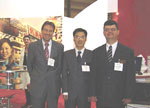  |
  |
| From Right to Left: Nordson's Jim Auber and Donald Lohse pose for the camera; Executives pose at Tredegar's booth; INDEX attendees check out what CB Packaging has to offer; Geoge Vacine and Hans VanBrackle promote ExxonMobil's Vistamaxx polymer; A meeting at Pantex's INDEX booth. | ||
The Machinist's View
Biax-Fiberfilm presented a new technology for spinning meltblown cellulose fibers. The cellulose arrives in an NMMO solution. Biax anticipates that this will be a major technology by the next INDEX show as it allows the use of a renewable, biodegradable material for the production of diapers and many other items traditionally made from polymer-based nonwovens. Biax has just applied for the patent. The company is in the process of building a 0.5-meter pilot line, which is due to be up and running by mid-July, although some orders are already being negotiated for research units.
Hygiene machinery supplier BHT-Bicma, which once again shared a booth with SSP Technology, introduced a new technology for the production of high density fluff cores. The advance here is that instead of continuous production, which involves straight cuts, Bicma's new unit molds the cores, yet still manages to produce 1200 pieces/minute. Bicma executives said there was a very strong reaction at INDEX from companies looking at new machines and upgrades. Bicma attributes the high level of interest to the fact that the machine makes a better product and saves money at the same time, compared to airlaid alternatives. The new core unit produces three-layer ultra-thin fluff/SAP cores with two layers of pure fluff outside and up to 50% SAP in the center. A pattern can be added to enhance liquid distribution.
Bicma also launched what it claims is the first-ever electronic repitch machine. Using servo drives, the unit changes the speed of the drum carrying the element of the product with the shorter pitch, to ensure perfect synchronization with the other components of the product. This avoids putting strain on the shorter pitch item and removes the need for a mechanical solution or specially-shaped drum.
The Dede 400 for the manufacturing of cellulose and airlaid materials in feminine hygiene and light incontinence was promoted by Bikoma at INDEX. With a capacity of 1000 panty shields or 500 sanitary napkins per minute, this machine features such options as three folding standard or easy-wrap, SAP application and CFZ layer.
Also new from Bikoma are the FSP 40 and FSP 50 fully automatic servo-driven filling and closing machines for PE-bag packaging of feminine hygiene products. FSP 40/50 can be fully integrated into a new or existing Bikoma machine, such as the new Dede 400 and can also be run as a separate unit. The 40/50 indicates the 40 and 50 pack/minute capacity of the two FSP machines available.
CB Packaging introduced the ASSO 300 Multipack-a fully automatic machine for multipack bag filling and packaging of soft, disposable hygienic products and wipes. The ASSO 300 can fill and package into polyethylene, polypropylene and other plastic films. CB Packaging says the machine's flexibility allows fast and simple format change and that welding quality is constant and very high. It is designed to be interfaced with any production line but can also operate as an independent unit.
Cognex used INDEX as an opportunity to describe its surface inspection system with synchronized view. This allows defects to be viewed from two different angles, which helps in their classification. Cognex says the technique was developed for the metals industry but it shows promise as a solution for nonwovens.
Airlaid machinery specialist Dan-Webforming's booth featured a prototype of new technology that can produce webs with fibers up to 18 mm in length, compared to the standard 10-12 mm. This technology lays fibers randomly to ensure even cross-machine (CD) and machine-direction (MD) strength. Carding machines, according to Dan-Web, produce webs with strong MD but weak CD.
Dan-Web introduced a new embossing technique, which puts designs on wet wipes using a wire rather than an engraved steel roller. The company says this is a more economical alternative and allows much quicker changeover. The technique is in its development phase but is believed by Dan-Webforming to have exciting possibilities for the industry.
Dan-Web also displayed a pair of chairs made from fluff pulp. The chairs have been produced by Swedish furniture manufacturer Lammhults and open up the possibility of a durable chair with the properties of plastic, but which is recyclable.
Deamatic, a unit of RML Raynworth, offers the Delta flat pantyshield and tanga automatic machine. Its production speed is 800 pieces/minute, and it runs at up to 160 m/minute and features include automatic splices and automatic tension control.
DelStar announced ISO 9001:2000 the achievement of certification for its Middletown, DE facility in the U.S. President and CEO Mark Abrahams said, "Achieving a second ISO 9001:2000 certification is a testament to the quality system that we have in place within DelStar Technologies. Middletown's certification is yet another step toward our goal of company-wide registration."
Considerable attention was paid to the Mach 500 baby diaper machine by Diatec. This machine was demonstrated just before the show at Sicell in Italy, the first customer for this technology and a second customer was expecting delivery just after the show. Mach 500 includes a double disc mill to defiberize the pulp and reduce dust. Another feature, the double drum core formation, allows pressing to different densities for different parts of the core. This allows quick initial capture of liquid followed by absorption. Quick changeover is possible thanks to servo-driven motors梠ne hour is typical梐nd this also gives considerable scope for changing product shape. Mach 500 is said to offer 80-85% efficiency and scrap of 3% or less. The footprint of the machine is small-a mere 12 meters for the core of the machine compared to a more typical 20 meters or more. Not only does this save space, it makes for better control of material and easier supervision, according to Diatec.
Dilo executives described the new Spinnbau Delta-Sigma-Card as a direct card because it operates without cross-layer and lap drafter. The batt is delivered in two, three or four layers directly to the consolidation process, which follows. This means the weight can be more than 100 gms with a fiber fineness of 1.7 dtex. The webs produced on the Spinnbau Delta-Sigma-Card might consist of three layers with a high weight profile evenness and an MD:CD tensile ratio of 3:1梚deal for high quality requirements, says Dilo. The card operates at up to 200 meters per minute in working widths up to 4 m.
Spinnbau has also developed the Turbo-Unit and Turbo-Card aerodynamic web forming machines, which are described by Dilo as a good alternative for the production of lightweight webs, when higher CD strength is required. The new Turbo-Unit M offers a CV value of around 5% and speed up to 60 m/min. The weight range is 30 to 250 gms, depending on the fiber fineness and web speed.
Dilo also promoted a new crosslapper type Hyperlayer, ready for demonstrations and trials with 2.5-meter webs and layering widths of up to 3.5 m. The Hyperlayer was designed for high speed lines and low-weight, fine fiber webs. Dilo says tests have shown the Hyperlayer may be run up to 50% faster than conventional crosslappers.
The latest development in folding wet wipes from Elsner Engineering Works, the ZFV-1-20, is able to run both dry and wet nonwoven fabric with a single discharge for manual stacking. Also from Elsner is the 2FV-1-20, which is designed to offer a combination of techniques in an inexpensive piece of equipment. The 2FV-1-20 offers wetting and an optional stacker. It is aimed at companies operating in smaller markets.
Elsner also brought out the ENR series of automatic nonwoven wipes perforator rewinders, which offers diameters of up to 250 mm. It has been developed in reaction to new lightweight, softer materials.
Fleissner's developments for the nonwovens industry include: the AquaJet-Spunlace System for hydroentanglement of nonwovens, high-performance through-air dryers and high-performance nonwoven production lines.
The AquaJet-Spunlace system will, Fleissner asserts, be used increasingly for the production of a new generation of spunbond nonwovens. According to Fleissner, the treatment of lightweight webs on an AquaJet-Spunlace line increases softness and improves volume. This can be performed at up to 600 meters per minute. Bonding with spunlace technology makes it possible to operate at higher production speeds, which increases efficiency and improves tensile strength. The system has been optimized for use with natural fibers. Bonding of flax and hemp made it possible to produce nonwovens for the automotive and home sectors in weights up to 1500 gpsm. The AquaJet process is particularly associated with cotton.
Fleissner also described how production lines for two- and three-layer composites can combine spunlace and airlaid technologies to optimize strength, bulk, softness, absorbency etc.
In through-air drying, Fleissner showed its one-drum and multi-drum concepts, with open areas of up to 960%, automatic fabric transport through the dryer and uniform temperature and flow profiles, measured over working width and time.
For nonwovens production, Fleissner presented lines for thermal bonding, chemical bonding with drum dryer or belt dryer; foam impregnation lines, heatsetting lines with width control; complete turnkey lines for carded webs, spunbond and airlaid webs; plus needlefelt bonding lines for floor coverings, filters, geotextiles, roofing felts, the automotive sector and so on.
 |
 |
 |
| Executives from NSC/Thibeau present their company's latest innovation, Excelle; a crowd gathers at Dilo/Spinnbau's booth; a display at Fameccanica's booth showcases the many products made on its machines. | ||
Hanwei demonstrated two machines梩he HD-KB-800 for easy-open panty shields and the HY-KB-500 for easy-open sanitary napkins. The HD-KB-800 is designed for easy operation and maintenance and can be easy to update as required. Safe running is aided by features such as an emergency brake. A new pattern 90-degree turning unit ensures products are positioned correctly during high speed running. The HY-KB-500 also comes with the 90-degree turning feature, plus a new tension control system, which has been adopted to ensure tension balance at any speed variation status.
A surgical cap-making line, the HM 200-7, which uses spunbonded PB to produce 80-100 caps per minute, was on display at Healthy Machinery's booth. It is reportedly easy to operate and maintain. Healthy Machinery also brought out a disposable filter pocket machine, the HM 200-11, for industrial air conditioning units. Its function is to remove dust from the air. The finished product is very large, hence a production rate of 15-20 pieces/minute.
Heng Chang Machinery showcased a full feature adult diaper machine, the FS-CNK-200, which is designed for medium-speed machine operation. It is fully servo-controlled, which means every shaft has individual servo motor control.
A new procedure for the application of tape tabs, wound pads and diaper cores was presented by IVF. It also showed a new high-speed production line for cotton pads. The NSS applicator system is designed to avoid the slippage that can occur during the application process. After being cut, the tape tab is accelerated to diaper web speed in a fraction of a second. During acceleration, the position of the tape tab is constantly controlled. The new technology consists of two independent applicator units, one for the drive side and one for the operator side of the machine. Each is automatically controlled by an alignment system. IVF says this ensures perfect alignment of the tape relative to the edge of the web. Each shaft of the applicator is driven by a servo motor. Size changes can be carried out without mechanical changes: all that is necessary is to recall the size data from an electronic recipe. The high speed cotton pad machine is based on rotary cutting technology. It is designed for production of up to 3200 pads per minute and comes in two, three or four-lane versions with manual or automatic packing.
Newcomer Curt G. Joa's participation at INDEX marked the first time the company participated in a trade show in history. According to executives, the main reason for attending was to present its European office in Andernach, Germany, which was opened to enable Wisconsin-based Joa to get closer to its European customers, and to reflect differences in the markets it serves.
Traditionally a diaper machinery manufacturer, Joa has developed a new technology platform for feminine care and light incontinence, both of which represent growth markets for the company.
K╯ters presented its first development results in the area of nonwoven finishing, the result of company efforts to establish itself beyond calendaring. A result of these efforts is the Twin KissRoll Applicator, in which two liquid troughs can be conveyed automatically, and in turn, to an applicator roll that is fixed in position. This means quick liquid change without the need to adjust web guidance. K?ters has even been able to present pilot projects in the area of padding or nonwovens of foam application.
In addition to the activities in finishing, K╯ters has completed the redesign of its two- and three-roll nonwoven calender.
Martin Automatic showed two non-stop splicing solutions-a taping overlap splice unit for narrow webs up to 510 mm (20 in.) and a tapeless butt splice unit for webs up to 4 m (160 in.) wide. Martin executives said the narrow web MSL splice unit makes its splicing technology more affordable than ever. The new MSL splices most substrates, including traditional nonwovens, airlaid nonwovens, films, tissues and laminate webs. This cantilevered splice unit was designed for easy operator access and thread-up. The MSL can be mounted in any orientation, allowing it to be retrofitted to existing unwind equipment. The MSL is completely self-contained, requiring no external guarding or safety interlocks. The standard MSL splice unit provides taped overlapping splices. It can also be equipped to provide heat-seal lap splices for thermo-bondable materials.
Martin Automatic also introduced a heatseal splice unit for use with its line of wide web automatic splicing unwinds. The ECP heatseal splice unit makes heatseal butt splices on thermo-bondable materials including nonwovens and films. Since they are made without tape or overlap, splices may, in certain applications, not need to be removed from the final product.
No taping, clamping or trimming is required with the ECP heatseal butt splice unit. The operator simply drops the web into the open splice unit, presses a button and the drawer-style unit closes to position the web for a splice.
The heatseal butt splice unit can be ordered on new Martin Automatic splicing systems, like the ECPLT for high-speed, ultra-low-tension processes. It is also available as a retrofit to certain existing Martin ECP splicers.
Optima used INDEX to discuss its alliance with Fameccanica to create Paksis, a new company created to fulfill the packaging needs of medium sized operations in the diaper market.
Osprey launched its SAP Only Recovery System. Osprey says the continuous process is easy to use: soft disposable products are loaded on an infeed unit; this material is then reduced in size and discharged automatically into the recovery section of the system; once separated from cellulose and nonwovens, SAP is redusted and conveyed to a convenient loading station. Customers can chose from a variety of waste handling options. Osprey says the system is ideal for manufacturers looking to maximize their short-term return on investment using materials already purchased.
Osprey also came out with its new Compact Phoenix Filter, which it says provides the innovative Phoenix design features in an economical, safe, compact unit. The system offers a combination of proven filtration technologies. Filtration levels and custom designs can be matched to individual applications.
Having adapted most features on its Water Vapor Permeability Tester, the Lyssy L80-5000, PBI-Dansensor made the machine a large focus of its INDEX booth. It has introduced software developments to deliver more accurate, better presented results. The company has incorporated an airflow valve for manual adjustment during testing. Another feature is that no grease or wax is required to secure the sample: instead, PBI-Dansensor uses a new, patented O-ring system, which works rather like a gasket.
In other news, the company introduced a new sample preparation, insertion and changing method on its L 80-5000 water vapor permeability sensor. The test sample is fixed to a self-adhesive sample car, which is inserted into the test chamber. Sample preparation can be completed within minutes, and produces a tight seal around the sample in the measuring chamber, with no grease required. PBI-Dansensor says the L80-5000 distinguishes itself from other water vapor permeability testers on the market through its "unique" measurement method. The instrument measures the time required for the upper chamber humidity to increase within a predefined interval, caused by the permeation of water vapor through the test film. The measured time interval is then calculated into the water vapor transmission rate expressed in gms/24 hours. PBI-Dansensor says this relation of time to permeability is easy to understand and interpret, and allows the user rapidly to master the use of the tester.
The details for a strategic partnership with an ink supplier were revealed by wet wipe machinery specialist Paper Converting Machine Company. The partnership will produce a water-based ink that does not suffer from rub-off when used by the customer and can be applied on-or off-line. This is part of a move by the company into the printing area. The company is working with customers to develop applications. Baby wipes is one possible use of this technology.
PCMC is also working on decorative embossing for the private label market. The system it proposes has the ability to emboss and print in-line.
Also on display was PCMC's Clipper RX-100 wipes production line for lab lines and entry level operations for flat pack wipes conversion.
RML-Raynworth announced a number of projects at INDEX 2005. It is working on a joint venture with Hanwei, which involves Hanwei's new machine for feminine hygiene products, the HD-KB-800 system. RML is also promoting Deamatic's new converting machine series, which is aimed at providing high capacity functioning with increased economics.
At INDEX, Santex Nonwoven/Cavitec introduced dryers normally used for textiles to the nonwovens industry. The system offers a high evaporation rate so it is suitable for high speed, high performance machines. The idea is to give an alternative to the suction dryer and offer a flatbed dryer, which can dry both sides of the product. The dryers have been operated at up to 350 meters per minute. The time needed to thermal bond has been reduced to 50-80 gpsm. This allows users to reduce the amount of binder fiber in the fabric because the binder fibers create more bonds. This gives loft and price advantages, according to the company.
Schober launched what it describes as a highly developed ultrasonic technology with speeds up to 300 m/min, designed to offer effective cost reduction and energy conservation. Schober claims that with Ultrasonics, the application of adhesive to bond web material and the energy consuming calender process to seal films, foils and nonwovens are obsolete.
Sonobond Ultrasonics took INDEX as an opportunity to show off its award-winning RingMaster Filter Bag Machine. RingMaster won the 2004 IDEA Equipment Achievement Award. It is an assembly system that ultrasonically attaches felted filter media to rigid plastic rings to create filter bags for chemical and other industrial applications.
A new edge sensor and a digital camera sensor was introduced by Tidland at INDEX 2005. The SE-38 First Edge Sensor is a digital edge scan sensor, which eliminates the effect of opacity variations in nonwoven materials. Tidland says the SE-38 is capable of detecting the first-edge of a web and ignoring any subsequent material voids and porosity. This is achieved using true digital pixel sensing. The DAC-004 Diode Array Camera Sensor is designed to enable users to sense a wide range of materials. The camera CCD has a total of 7450 pixels and can discriminate up to four edges out of 255 to provide web width output. The digital sensing offers high immunity against contamination, dust particles, oil, vapors and water, according to Tidland. The DAC-004 offers analog and digital connectivity via field bus interfaces and runs in a variety of applications, from fixed sensor rewinding, center edge and line guiding, to web width measurement.
MD Viola presented its latest baby and adult diaper machines. The MD 400 for babies operates at 400 units/minute, while the MDA 200 for adults operates at 200 units/minute.
Zuiko has introduced a diaper
production machine designed to switch easily between pull-up and fastening
diapers.
 |
 |
Lucca, Italy-based A. Celli
Nonwovens has introduced the Neck-in management system and
Slitto-Motor. These are the results of a research and development
program Celli started three years ago designed to generate
innovation in the area of automation and operator-friendliness.
Neck-in management is operator-friendly software meant to design
reel size and can automatically manage fabric elasticity and
shrinkage, while coordinating both knife positioning and cardboard
core cutting.
Slitto motor is an A. Celli-patented,
independently motorized counterknife holder that can drive
counterknife blades without a shaft. In addition to allowing better
cut control, this system drastically reduces blade replacement time
that increases productivity records and line capacity. The company
has also introduced the Wingformer, a system for airlaid web
formation capable of guaranteeing productivity of more than 450
kg/m/h on an industrial scale. Additionally, A. Celli will be
holding the third edition of its Winding School, a technology
transfer and training workshop, in Ft. Lauderdale this November.
Website: http://www.celli.com/.
 |
| Photo courtesy of Ason Neumag |
Ason Neumag Corporation, Ft. Lauderdale, FL, a division of Neumag Zweigniederlassung der Saurer GmbH & Co., recently celebrated the opening of its state-of-the-art pilot facility, the Spunbond Solutions Center, in Neumüster, Germany. The patented AST process offers several unique core competencies, such as shrink-free PET, ultra-fine filaments, high-speed spinning and high production and fabric qualities. The 1.2-meter-wide pilot line, a smaller version of a full production facility, highlights all the components of the intellectual properties of the AST patents. In addition to core Ason Neumang technology, the line incorporates components from Küsters, Edelmann and other first-tier suppliers. A needle loom is currently being added to the line. Website: http://www.asonnuemag.com/.
Green Bay-based Associated Machine Design has introduced the W-Flex series wipes production line. The line can produce continuously folded flat-pack style wet, dry or treated wipes. Various solutions and coating systems are available depending on the intended use of the product as well as a wide range of fluid viscosities. Individual wetting tube control can be accomplished using a patent pending valve and control system coupled with dedicated flow meters. The system can be equipped to read out and monitor critical machine process functions allowing for data collection and alarming. Website: http://www.associatedmachine.com/.
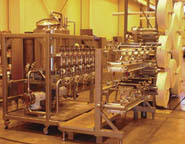 |
Industrial weaver AstenJohnson, Charleston, SC, offers a full line of products for spunlace, spunbond, meltblown, airlaid and wetlaid processes. The company's latest offering for spunbond/SMS and glassmat production is the WebMaster F325, specifically designed for the rigors of high-speed nonwovens production. It provides exceptional hold down while delivering support and release properties. Also, the GlassMaster 200NP provides a balance of properties required for the production of high quality fiberglass-based mats. Website: http://www.astenjohnson.com/.
Pistoia, Italy-based Automatex, has developed a needleloom system, the Automair. The system uses suction directly on the stripper and bedplate to reduce down time for cleaning. The looms are built for continuous production speeds of at least 1500 rpm with a 40 or 55 mm stroke. The patented, forged camshaft and oiling system are similar to those on an automobile. The absence of bearings and heavy construction drastically reduces maintenance and noise levels by 20-30%, eliminating the need for a sound room. Website: http://www.dawsontextile.com/.
 |
Rotary cutting and embossing dies and anvils producer Best
Cutting Die, Skokie, IL, is known in the converting industry for its
complete in-house vacuum heat-treating capabilities and services.
The company has recently introduced a second vacuum furnace
that is two times the capacity of the largest furnace in its
heat-treating department. The company has also introduced a new
large-diameter capacity cylindrical grinder. In addition to a number
of smaller ovens and the large capacity vacuum heating treating
ovens, Best Cutting Die has large, state-of-the-art cryogenic
chilling chambers with the capability of sub-zero treating to 300
degrees.
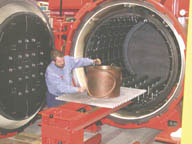 |
This procedure follows heat-treating and is used to stabilize the material to increase the life of the dies. Website: http://www.bestcuttingdie.com/.
Boschert, Loerrach, Germany, offers a round/square seat geometry
for its safety chucks called the VT-7 style. This new style
separates the load of the roll from its torque, resulting in
extended life for the roll shaft journal and for the seat of the
safety chuck. The bar rides on the seat during operation because the
load of the roll is on its round segment. This translates into a
smoother, vibration-free run every time.
The chucks are
easily retrofitted by simply removing the existing Boschert VT
insert and installing the VT-7. Turnaround time for the change is
less than five minutes.
Boschert has also introduced the
fourth generation of positive locks for its safety chucks, the Type
IV. It is also more robust than any other Boschert lock. This
feature can be ordered on the new safety chucks and is not intended
to retrofit existing ones. Website: http://www.boschertllc.com/.
 |
Designed for slitting and edge sealing synthetic materials where
narrow widths, down to the inch, are desired, Branson Ultrasonics
has introduced the Model F-20 Ultrasonic Slitter which produces 20%
higher amplitude for faster weld cycles. Ultrasonic slitting seals
the slit edge with vibratory energy at rates ranging from 40 to 300
surface feet per minute. The sealed edge is tapered with no bead or
bulk and eliminates the “dog bone” effect on rolled material.
A complete ultrasonic slitting setup includes a 2000 bca
remote power supply, converter, carbide-faced horn, spring-on-air
counted cutting anvil, booster and cable. Website: http://www.bransonultrasonics.com/.
A producer of web guiding systems, BST International, Elmhurst,
IL, has introduced two products for the control and guiding of
moving webs. The ekr Pro Com 60 is a compact unit designed for
simple integration and use over a wide range of printing, converting
and OEM applications. The unit uses a unique new operator interface,
which combines color-coded icons for simplicity and an LCD dot
matrix display, with data in both numeric and graphic form. The ekr
Pro Com controller is available in both stand-alone or panel-mount
units, providing the flexibility for integration into OEM systems.
Also introduced is the ekr Pro System, a web or process
management system capable of complying with automated applications
such as web width measurement, splice control and tire
manufacturing.
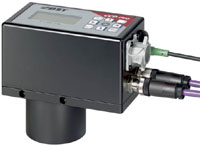 |
The system integrates the ekr Pro Com family of controllers, a
new CCD Pro Sensor, Pro Logic module and a new ProTouch touch screen
user interface. Website:
http://www.bst-international.com/.
Chase Machine & Engineering, West Warwick, RI, recently
celebrated its 50th year of web handling. Known for its design and
manufacture of ultrasonic web handling machinery such as laminators
and slitters, Chase continues to provide its customers with
state-of-the-art solutions for their web handling challenges.
During the last several decades, Chase has been privileged
to work with technological partners such as Branson, Dukane and
Herrmann Ultrasonics. Website: http://www.chasemachine.com/.
Chicago-based Chicago Cutting Die is now manufacturing a complete line of embossing and crimping tools for the nonwovens converting industry using premium tool steel in the manufacturing process. The rolls can be fully heat treated, surface heat treated or used with an ultrasonic sealing horn. Website: http://www.chicagocuttingdie.com/
 |
A machine supplier within the airlaid industry, Dan-Webforming,
Aarhus, Denmark, is combining airlaid technology with other
technologies to create new product applications. These combinations
include carded-airlaid-carded (CAC), carded-airlaid (CA),
spunbond-airlaid-spunbond (SAS) and airlaid-spunbond-airlaid (ASA)
technologies.
Dan-Web’s forming technology can also be
combined with a variety of other technologies such as spunlace and
airlace, spunbond and meltblown, or similar forming technologies.
Website: http://www.dan-web.com/.
To address current
production demands for the hygienic and diaper film markets,
Davis-Standard, Pawcatuck, CT, has expanded its non-woven coatings
capabilities to improve processor outputs and product quality while
reducing waste.
Recent technology has enabled Davis-Standard
to develop the industry’s most complete and technically advanced
line of nonwoven machinery for the hygienic film market. Website: http://www.davis-standard.com/.
 |
Tension equipment manufacturer Dover Flexo Electronics,
Rochester, NH, has introduced the WebHandler tm3 digital tension
controller. The compact and simple WebHandler tm3 brings precise,
automatic closed-loop web control to nonwovens converting machinery
at a highly competitive price. Working with input from DFE tension
transducers, the compact Webhandlertm3 controls output to a
tensioning component such as a pneumatic brake, clutch or DC drive.
The controller maintains accurate, repeatable tension on
nonwoven webs in any process zone. Website: http://www.dfe.com/.
Franklin, MA-based Dynisco has introduced a wear-resistant coating for melt pressure transducer diaphragms called DyMax. DyMax has replaced Armoloy as the industry standard for melt pressure transducer coatings.
 |
All Dynisco melt pressure transducer products with Armoloy
coating will now come with DyMax.
This unique coating adds
abrasion resistance without limiting sensor performance.
Dynisco has also introduced the newest SPX Series of smart
pressure transmitters.
The SPX Series is designed for all
extrusion and process pressure measurements, ranging from 25 to
30,000 psi.
The series is available in a variety of mounting
configurations including the process industry standards: large
remote diaphragm seal, threaded, small remote diaphragm seal and
many other custom mounting configurations. Website: http://www.dynisco.com/
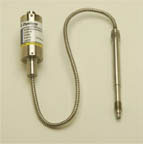 |
Elsner Engineering Works, Hanover, PA, has introduced its Model
ENR-760 and ENR-1000 Automatic Nonwoven Rewinders.
The ENR
Series of automatic nonwoven wipes perforator rewinders offers
converters the opportunity to unwind, perforate, slit and rewind a
preset count of nonwoven sheets in a roll, automatically, in a
single machine.
Finished rolls with tails glued closed and
ready for automatic insertion into canisters are available with a
single operator to monitor machine operation.
The ENR-760
produces up to four seven-inch-wide rolls per log at 15 logs per
minute or 60 pieces per minute; the ENR-1000 produces up to six
seven-inch-wide rolls per log at 15 logs per minute or 90 pieces per
minute. Website: http://www.elsnereng.com/.
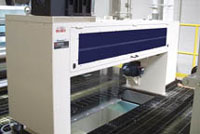 |
Monomonee Falls, WI-based Enercon has introduced the Plasma3, a
proprietary atmospheric glow discharge surface treatment system for
functionalizing narrow and wide nonwoven webs. The Plasma3 system
can modify the entire fiber network of webs with dual-sided
treatment.
Uniformity of treatment is achieved and
functionalization is precisely controlled to promote many
hydrophilic surface properties. Process chemistry consumption costs
are extremely low, reacting in the discharge area and yielding high
and long-lasting surface energy to provide improved adhesion of
dyes, inks, coatings and adhesives. Website: http://www.enercon.com/.
Fab-Con Machinery Development Corporation, Port Washington, NY, produces final state finishing equipment for the knit and nonwoven textile segments.
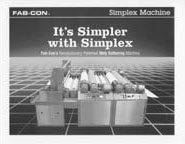 |
The company’s most recent offerings have focused on the
development of a reliable, highly productive mechanical systems for
improving the softness of certain woven, printed knit and nonwoven
fabrics.
Fab-ConDigital simplex and Fab-Con Digital S Series
machines utilize mechanical means comprising of nips made up of a
combination of rollers, breaker bars and metal shoes to impact an
improvement in fabric surface hand attributes.
When compared
to chemical means of achieving hand or softness improvement, a
mechanical method has been proven to be highly cost advantageous in
designated applications. Website: http://www.fab-con.com/.
Fleissner opened a newly upgraded nonwovens technical center at its Egelsbach, Germany headquarters and provided a workshop for customers of the nonwovens industry under the motto “nonwovens speed-up.”
 |
The workshop accomplished two things for the company. The first was to demonstrate its desire to lead dynamic development in the nonwovens market with its high-performance machinery; the second was to demonstrate that Fleissner's new line is available for hydrentanglement trials at speeds from 200 to 600 m/min. Website: http://www.fleissner.de/.
F.O.R., a division of Fincarde based in Biella, Italy, has
developed the Injection card specifically for the nonwovens
industry.
This card features patented processes which have
been developed to meet the demands of new fibers, higher production
requirements and quality.
The Injection card has a double
doffer on the breaker cylinder, and the injection technology on the
finishers cylinder produces a superior quality web a higher
production rate.
The technology can process micro denier,
short fibers and delicate fibers without the limitation imposed by
workers and strippers. Website: http://www.dawsontextile.com/.
Manitowoc, WI-based Foster Needle has introduced the Conical Star
needle. The new design mixes the efficient fiber-carrying capacity
of the Star Blade with a stable conical blade shape.
The
needle is best suited to produce technical, highly densified webs
where needle breakage has been a problem. Website: http://www.fosterneedleusa.com/.
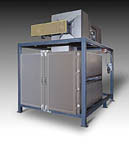 |
Ideal for process-heating a wide range of air-permeable products, Glenro’s Through-Air Dryer supplies heated air to the interior of the dryer enclosure through a perforated plenum mounted above the product line. Heat transfer throughout the entire product is almost instant. Air drawn in through the suction plenum is returned to the burner chamber for reheating and re-use. The dryer has a small footprint, measuring only 6.5 feet long by seven feet by 4.5 feet deep excluding ductwork and heating apparatus. Website: http://www.glenro.com/.
Ulatrasonic plastic bonding and welding systems producer Hermann Ultrasonics, Schaumburg, IL, has introduced the Microdialog touch CS operator interface to provide process control and easy operation.
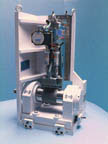 |
An industrial 12-inch, full-color touch screen allows the user to
enter process parameters, save weld recipes and visualize important
process data as graphics. Fully digital ultrasonic generators
Dynamic digital control CS provide peak power outputs of up to 4000
watts.
With the new bus interface, the generators can be
integrated seamlessly into the microdialog touch CS control scheme,
allow remote settings via the main machine PLC or external
statistical process data login for quality assurance.
The
actuator VE CS provides a rigid mounting of the ultrasonic weld
horn, easy alignment and extremely precise positioning of the weld
horn. Website: http://www.hermannultrasonics.com/.
Water treatment specialist, Idrosistem Energy, Bassano del Grappa, Italy, has introduced its latest sand filtration with flotation device combined in the same unit.
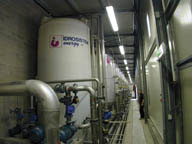 |
The system works using a recycling mechanism in which the water is saturated with air similar to the way it is in a flotation unit. The result is increased efficiency in the removal of any finishing products, including surface agents and oils. It is now possible for spunlace producers using cotton to treat wastewater directly in the sand filters without having to pre-treat the fiber in a flotation unit. Website: http://www.idrosistem.com/.
Sparta, NJ-based Indemax, Inc., has been producing direct replacement hot-melt glue machine parts for machines made by such companies as Nordson, Meltex and Graco since 1978. Indemax makes special hoses up to 80 feet long with inside diameters in excess of six inches, used to heat everything from polymers to lipstick. Hose to actual glue temperatures translate to optimum control and extended hose life. Indemax nozzles are sized to within .0005 inches of the intended diameter, and modules are drip-proof because they are shut off at the tip, incorporating double hydraulic seals. Website: http://www.indemax.com/.
Independent Machine Co., Fairfield, NJ, has introduced its latest system for slitting and traverse winding nonwoven material. The system includes the insertion of a polyethylene liner at each winding position to protect the product as it is spooled or rewound and allow for each position to traverse or pancake wind. The new 10-inch-wide system features six Smartwinder 2000 modular cubes which operate inline with the unwind slitter section. The slitter includes a cantilevered unwind with programmable constant tension, auto edge guide, adjustable peel off roll, entry and “S” wrap pull rolls and the exclusive IMC interchangeable slitting assemblies for shear, score and razor slittings. Website: http://www.independentusa.com/.
Isra Surface Vision, Norcross, GA, is a worldwide producer of surface inspection systems for nonwovens. Based on the Smash Web Processor, a new faster and advanced system is available. The system is a modular system that combines superior capability, speed and expandability at an affordable price. The open architecture allows the real time inspection information to be interfaced with PLCs, control systems and networks. The defects can be zoomed individually or displayed in a photo album format with cross web and down web location, size and type. Website: http://www.isravision.com/.
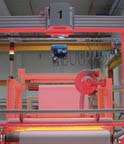 |
Testing and equipment manufacturer James H. Heal, Halifax, U.K., has added a range of instruments to its offerings. Included are the xenon arc light and weather fastness tester, Appolo, and a advanced instrument facilitating the close control of sunlight, temperature and humidity. An addition to Heal's Martindale family is the Mini-Martindale, a single-head abrasion tester that can be used for a range of applications. The digital tear tester, Elmatear, now has improved jaws and can be connected to a PC for analysis of test results. TruBurst, Heal's intelligent bursting strength tester is now available as an advanced model that allows cyclic testing. Website: http://www.james-heal.co.uk/.
Küsters has introduced the Krefelda calender innovation that helps cut both time and production costs.
 |
The Twin Calender enables the changing of a pattern or an easy
switch from embossing to bonding within minutes.
The Twin
Calender can be equipped with all Küsters system rolls.
The
standard program provides for material widths up to six meters and
reach production speeds of up to 1000 m/min.
Temperatures of
up to 275°C are also possible, as well as the infinitely variable
line force up to 300 N/mm over the entire material width for ideal
performance and ease of operation. Website: http://www.kusters.nl/.
 |
The Watt Fluid Applicator by Huron, OH-based Latanick Equipment, is an “economical process” that applies a measured amount of liquid accurately and evenly, moving at variable processing speeds on a manufacturing line. Fluid application has been applied up to a 96-inch width in the cross direction. It can be controlled from a thread speed exceeding 1500 feet/min. Website: http://www.plantfloor.com/.
Rockford, IL-based Martin Automatic has introduced a splice unit for the production of disposable products. The new MSL splice unit will splice most substrates, including traditional nonwovens, airlaid nonwovens, films, tissues and laminated webs. The MSL can be provided as part of a separate unit for integration by the customer. The cantilevered splice unit was designed for easy operator access and thread-up. The flexibility of the MSL allows it to be mounted in any orientation, making it ideal for retrofitting to existing unwind equipment. Website: http://www.martinautomatic.com/.
 |
Carding machine, fiber preparation and blending line manufacturer Masias Maquinara, SA, has developed a new airlaying line that enables the user to feed a pad formed with virgin or recycled fibers directly to an oven or a needle punch machine. Masais installations include complete fiber preparation lines, air laying and pad forming units, ovens and cutting and rolling units. The airlaying line is currently available for trials in the Masias showroom. Website: http://www.masias.com/.
Massen Machine Vision Systems, Lohnerhofstr, Germany, continues to solve the most demanding quality problems in industrial nonwovens production a new fast, automatic inspection system that ensures the esthetical quality of color-printed nonwovens. Website: http://www.massen.com/.
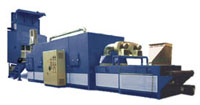 |
Westerly, RI-based Maxson Automatic Machinery Company has introduced its Dual Position Roll Stand, that is able to handle two rolls. Each position can lift a roll up to 84 inches in diameter and up to 7000 pounds at speeds up to 3000 feet per minute. Hydraulically powered, each position loads a roll by lowering both arms and then moving each toward the roll. Sufficient clamping pressure is exited to drive the chucks into the core. Website: http://www.maxsonautomatic.com/.
Miller Weldmaster Corp, Navarre, OH, has introduced a continuous filter tubing system. The Miller system is able to pull fabric off of rolls and pre-fold it into a desired tube diameter and then weld it into a tube. After the filter has welded the filter, it is pulled directly into a precise cut-to-length system. A programmed footage counter or optical sensor dictates the filter bag length.
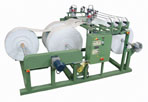 |
The filter bag is then swept into any package or material handling system desired. The Miller System has line speeds up to 60 feet per minute with limited-to-no operator involvement. Miller Weldmaster also produces a complete line of fabric welding and handling equipment for the cured-in-place pipeline industry. Website: http://www.vinylwelders.com/.
Lavale, MD-based National Jet Company, manufactures spinnerets
and melt blown die tips for the nonwovens industry.
The
company’s latest offering is the Najet Model micro-drilling machine,
to be installed recently at its production facility in Lavale. The
CNC drilling machine will help reduce manufacturing lead times and
reduce the cost of spinnerets.
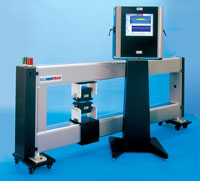 |
Additionally, the company has recently received its ISO 9001:2000
certification, which applies to National Jet’s micro-machining
services, including the latest in micro-hole technology used in the
textile industry. Website: http://www.najet.com/.
Measurements and
control products manufacturer NDC Infrared, Irwindale, CA, has
introduced several products.These products have been designed for a
variety of nonwovens and textile applications, from a simple carded
line to needlepunched lines to SMS processes.
The Pro.Max
Process/Product Management System features hardware and software
solutions for managing up to three product scanners. The system is
the first to combine a PC-based SCADA system with mission critical
hardware. The Pro.Max overlays on top of NDC's traditional 6100 and
8000 scanning platforms and provides and added dimension of process
management capability. Also introduced is the MiniTrak scanner
design for webs up to eight meters wide. The cross-web beam is an
8-inch by 8-inch U-beam design, whose outer shell houses virtually
all of the mechanical and electrical components. Also, the new FS710
NIR Guage is a high accuracy forward scatter gauge capable of
measuring basis weight in nonwovens applications. Website: http://www.ndcinfrared.com/.
Dawsonville, GA-based Nordson Corporation, has introduced a
nonwovens system that provides disposable product manufacturers with
new performance capabilities that improve production efficiency and
reduce adhesive usage.
Universal Platform dispensing designs
were expanded to include 22- and 25-millimeter-wide modules, Speed
Slot applicators and Controlled Fiberization spray applicators.
New developments in Contour Coat equipment enhance hot melt
adhesive pattern flexibility and production alternatives.
The expanded VersaBlue melter series gives manufacturers
additional production flexibility and capability.
Additionally, Nordon’s Center of Excellence testing facility
actively continues research and production trials for nonwovens
manufacturers to accurately qualify substrate characteristics and
costs.
It is the first pilot facility capable of producing
mono and bi-component spunbond, meltblown and SMS composites at full
production speeds.
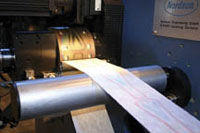 |
System development for spinning and formation has resulted in the finest bi-compnent webs in the industry. Recent visits by Chinese delegations have most certainly contributed to additional machine sales in China, an important target market. Website: http://www.nordson.com/.
Osprey Corporation, Atlanta, is expanding its operations in
Conyers, GA, to consolidate all of its systems product lines with
its auxiliary plastics machinery manufacturing.
All of the
administration, sales and engineering staff will remain at the
Atlanta location. Osprey has also introduced several new products.
The patent pending Fluff and SAP Extraction System offers an
increased output rate while reducing capital expense, energy
consumption and valuable floor space.
The system’s new air
balancing feature reduces housekeeping issues associated with other
systems. Also, Osprey has expanded its MS line of air separators
used in trim, cull and scrap collection applications.
The
new expanded line includes arrangements for air volumes of 4000 to
40,000 cfm under normal operating conditions.
The new
Profiler now offers real-time quality control for soft disposable
producers with an easily installed sensor. The profiler will
instantly and efficientsly detect products that are not in user
specification while reducing production line waste. Website: http://www.ospreyfilters.com/.
 |
PBI-Dansensor, Glen Rock, NJ, offers the LYSSY Water Vapor
Permeability Tester for quick and accurate assessment of moisture
barrier properties and increased reproducibility. Unlike the
traditional cup test method in which ambient moisture and
temperature created constantly changing conditions and require
longer test times, the LYSSY MVTR tester works within a sealed
chamber that features a controlled humidity and temperature
environment. LYSSY water vapor transmission testers are used to
assess the quality of nonwovens, films, blister packaging,
metallized foils, impermeable fabrics, PUR-coated fabrics for
nursing and surgical and hygienic membranes.
PBI has alsor
introduced has introduced the Total Gas Control Unit, which allows
coffee packagers to manage the entire gas purging and monitoring
process in a single unit.
A combination of on-line gas
analysis, off-line spot test analysis, electronic flow control of
the gas supply and optional electronic controlled gas mixing
maintains uniformity in gas packaging, reduces operator dependent
fault possibilities and reduces gas costs by avoiding wasteful
overflushing. Website: pbi-dansensor.com.
Focusing on conveyor fabric cleaning problems, ProJet BV,
Meerssen, Netherlands, offers the ProJet line of fabric cleaning
products that focus 1200 to 5000 psig water pressure at a
consumption rate of 0.25 gpm per cleaning nozzle.
With
varying impingement angles, they penetrate and clean not only fabric
surfaces but throughout the fabric.
The cleaning technology
incorporates an existing fabric turning roll as a backing surface
during the cleaning process to stabilize the fabric and block
contamination flow.
As the high-pressure needle jets
penetrate the fabric structure and open fabric pores, the backing
roll reverses water mist and contamination flow into the cleaning
hood to collect all contamination during cleaning and positively
drains the contamination into a save-all catch pan. Website: http://www.pro-jet.nl/.
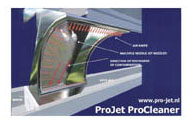 |
Sensor Products, Inc., East Hanover, NJ, has introduced D-Nip,
the first electronic, real-time nip profiling system. The system is
a valuable process control tool for any web-based production
environment as it reveals inaccurate roll alignment, roll skewing
and crown deficiencies. These problems can result in unevenly
processed, wrinkled or mottled products, compacted sheets, excessive
sheet breaks and blackening during calendaring.
The D-Nip
consists of a sensor element chain and a data collection unit that
resides on the roll surface and journal. Website: http://www.sensorprod.com/.
Pinhole detection specialist, Summit Engineering, Columbia, SC, has introduced the DC-3000 line of inspection equipment. The 3000 series offers many new features including dynamic edge guide tracking and programmable inspection lanes. Intelligent inspection lanes automatically move with the product to ensure accurately defined lanes. Standard roll mapping and a user-friendly product set-up screen simplifies product change. Roll map history is provided with every roll. Product records include defect and count size definitions that permit categorizing alarm conditions with each set-up. Basic units include 16 alarm points. Website: http://www.summitengineering.com/.
Taber Industries, Buffalo, NY, has introduced the Rotary Platform
Abraser for use in evaluating the wear resistance of nonwoven
materials.
A recent in-depth study for a specific nonwoven
application showed that the proper wheel selection and test
procedure is critical to ensure repeatable and reproducable results.
Website: http://www.taberindustries.com/.
 |
Testing equipment manufacturer Textest, Zurich, Switzerland, has introduced the FX 3000-III automatic hydrostatic head tester hydrotester. The Hydrotester III reduces observation time in a Hydrostatic Head Test to zero with an automatic drop detector.
 |
This detector recognizes the penetrating drops and terminates the test after the first or third drop has appeared. This completely eliminates the need for an operator to watch the specimen and all drops are rated equally, eliminating all inter-operator variation. The instrument may also be used without the automatic drop detector. The result is displayed in any of three selectable units of measure. Different test heads with different test areas can easily be fitted to the instrument, and 11 pre-programmed pressure gradients and pressure programs make it possible to test in compliance with any known standard. Website: http://www.textest.ch/.
Philadelphia-based Thwing-Albert Instrument Company has recently
completed the necessary requirements to achieve ISO 9001:2000
certification. Among the testing instrument company's new offerings
are the ATS-600 absorption test system.
The system utilizes
a state-of-the-art optical sensor and syringe pump system to quickly
measure liquid absorption rate and capacity critical to product
performance of paper towel products, sanitary products and super
absorbers.
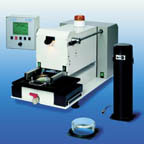 |
Thwing-Albert has also introduced a line of PC-controlled
universal materials tester, the EJA Vantage Series, suited for
nonwovens testing.
Two low-profile frames are available
providing capacities up to 1 kN or 5 kN or tension/compression
force. Also developed on the EJA Vantage platform, Thwing-Albert’s
burst tester is designed specifically for testing wet and dry
materials that exhibit low strength characteristics. Website: http://www.thwingalbert.com/.
A provider of machine vision inspection systems and products to
the manufacturing and converting industries, Santa Rosa, CA-based
Webview, Inc., has introduced Webview
3000-L.
This
patented system upgrades any existing laser-based web inspection
systems at an affordable price. When installed, the Webview 3000-L
offers all the features found on Webview 3000 camera-based systems
including two imaging channels, complete roll maps and more.
The Webview 3000-L uses an existing laser scanner and
receiver, allowing installation with virtually no downtime required.
Webview give its customers with laser scanners and receivers
offering the latest technology and performance. Website: http://www.webinspection.com/.
Posted on August 1, 2007 @ 11:30 am
After five years in development, Monadnock Non-Wovens has developed a unique bonded composite of meltblown Halar and polypropylene. It combines the unique characteristics of polypropylene and Halar in one intimately bonded composite.
“It will have filter applications worldwide where the combination of high-dirt holding, relatively low cost and extreme inertness for use where chemical or radioactive attack is expected,” said Monadnock’s technical cirector Rowland Griffin. “Although primarily developed to meet demand in the liquid filtration market and the chloro-alkalis chemical, electronic and pharmaceutical industries, it has other potential uses in Homeland Security as personal barrier protection or other replacement for expensive membranes such as PTFE.”
Halar E-CTFE is a fluoropolymer that has chemical resistance properties similar to PTFE in that it is highly unreactive to acids, alkalis, ozone, heat and radiation. Its ability to resist permeation by aqueous solutions is unmatched versus other commonly used surface webs (i.e. carbon, polyester and glass). It also has exceptional electro-negativity and offers a very smooth structure that discourages biofilm formation. For several applications Halar`s properties, including its tolerance to pH 1-14, makes it more suitable than both PVDF and PTFE. The polypropylene layer extends the service life under particle challenge saving time at the filter fabricator and ensures a constant bond between the media. This breakthrough overcomes some of the challenges of forming layers with Halar with its “non-stick” behavior without addition of glues or other
extractables. “This could lead to other possible uses including back-washable filter bags or elements or even
water impervious structures that allow air to pass in battlefield equipment,” said Mr. Griffin
Monadnock Non-Wovens, a supplier of roll goods to the filtration industry, plans to supply the unique composite in rolls up to 42 inches wide, with roll diameters up to 40 inches, and nominally rated to filter between 1-20 micron.
Review & Forecast
As 2005 draws to a close, nonwovens executives describe the year as positive for the industry. Despite excalating raw material prices, overcapacity in some key areas and severe competition, the nonwovens industry continues to triump. Looking ahead to 2006, the industry will continue to grow, thanks to new capacity investment and continued global penetration.
The nonwovens industry began the past year with a positive
outlook and demonstrated continued growth through the third quarter of
2005, according to James Schaeffer, CEO of the Polymer Group Inc. “While
the optimism has been dampened by an extremely difficult raw material
environment, as a result of a series of global natural disasters, 2005 was
still a good year for the industry as a whole,” he said.
At PGI,
it was a year of continued improvement and considerable activity related
to laying the foundation for future growth, with a new spunmelt line
installed in Cali, Colombia and additional spunmelt expansions kicked off
in North America and Asia, Mr. Schaeffer added. “These capital investments
position us for continued progress and put us where our customers need us
to be. Additionally, they provide a platform from which to launch
innovative products using this technology. We also continued rolling out
new products as a result of our focus on innovation and relationship
expansion with key customers.
“In 2006, new materials, new
applications in non-traditional markets and new requirements are expected
to drive growth for the industry and our company. Additionally, we see
increased innovation efforts becoming more paramount to maintaining a
competitive position in the industry. We are pleased to have helped lead
the way for the industry by using cotton in baby wipes for the first time
and expect to continue to leverage our technological expertise to
introduce new products to the market.”
Looking ahead, Mr. Schaeffer
said that nonwovens are expected to increase their penetration in an array
of commercial markets—including home building applications like foundation
barrier fabrics, carpet backing and breathable construction materials.
Nonwovens should also play a role in rebuilding efforts of
hurricane-devastated areas.
“An increase in consumer safety
regulations could lead to greater use of flame-resistant (FR) materials in
bedding and home furnishings, and more stringent environmental standards
will drive the use of nonwovens in filtration,” he said. “We also see
demand for value-added wipes continuing, as customers remain focused on
innovation and development of products that will help them differentiate
themselves. PGI has a favorable position in this market and is continuing
to develop high-performance wiping products. Alternatively, we expect
commodity wipes materials to see additional pressure, as consumer product
makers increase performance requirements.
“In the coming year, we
expect the industry to continue to invest in growing markets but also
expect to see more consolidation among industry players as some
technologies reach their peaks,” Mr. Schaeffer added. “We think the
overcapacity in certain markets that has created unfavorable market
conditions will most likely be addressed in 2006 and ahead. Just as in the
stock market, there will be winners and losers, and we are focused on
being the winner in our markets. The companies that have done the right
planning, executed well and invested judiciously in the right technologies
to meet market needs will be rewarded.”
In conclusion, Mr.
Schaeffer said that at PGI, executives feel great about its strategy,
team, products and technologies, development efforts, the investments it
has made for the future and how it is positioned to serve its customers.
“We are only at the beginning of an exciting period of growth, and we are
confident in our ability to meet the challenges and seize the
opportunities of the future.”
The highlight of the year for Johns
Manville was its plans to build the largest, fastest and the lowest cost
structure nonwoven glass mat production facility in Etowah, TN to support
its growing roofing, wallboard and specialty customers growth, according
to vice president of roofing materials Zain Mahmood. This line will have
the capacity to produce over one billion square meters of nonwoven glass
mat and will also serve its emerging global glass mat customers in China,
Latin America and the Middle East.
“This new investment, coming on
line in early 2007, emphasizes the focus Johns Manville has on nonwovens
as a platform for future growth,” Mr. Mahmood said. “We are also launching
many new products in our core markets that will be produced with the help
of this new investment.”
Second, JM is excited about its newest
capacity in spunbond nonwovens, which is expected to launch in the third
quarter of 2006. This state-of-the-art facility will produce ultra
low-weight spunbond applications for the emerging markets of Central and
Eastern Europe, Turkey, Middle East, North Africa as well as Western
European roofing customers. With the Johns Manville Synthetics nonwovens
research facility in Bobingen, Germany, many new technical challenges are
being overcome, Mr. Mahmood continued.
Together, these two
investments mark over $100 million of investments for Johns Manville in
recent months.
“Third, the nonwovens industry is clearly facing
some headwinds today,” he said. “The continued volatility of raw material
pricing, especially for hydrocarbon-based raw materials, energy and
transportation, is effecting everyone in the industry. In recent months,
JM has asked its customers to share the burden of these increased costs
with 5-15% surcharges, depending on the markets. With their own costs
skyrocketing, customers have shown a propensity to shoulder this burden
with JM.
“With market discipline, the long term prognosis for this
market is strong, since nonwovens allow our customers to meet requirements
related to strength, moisture resistance, fire resistance and other
emerging codes. Nonwovens, at the end of the day, provide an economic
value proposition for our customers that is undeniable.”
Fourth,
with significant technology investments in nonwovens, Johns Manville is
building a global research and development capability to support its end
use customers. This will result in a Global Non Wovens Technology Center
under the premise of Johns Manville Technology Center with locations in
Littleton, CO, Bobingen, Germany and Shanghai, China.
“Finally,
Johns Manville is the world’s leading provider of glass and polyester
nonwovens in construction and specialty materials sectors with locations
in Bobingen, Karlstein, Steinach, Wertheim and Berlin in Germany; Trnava,
Slovakia; Shanghai, China and Waterville, OH and Etowah, TN in the U.S.,”
Mr. Mahmood concluded. “JM nonwovens leads the global markets in roofing
shingles, Built up roofing, wallboard solutions, synthetic underlayments,
flooring applications, battery separators, filtration media and many other
applications.”
“During 2005, the nonwovens industry continued to
aggressively pursue increased product performance to meet customers’needs
and invest in capacity expansions, while balancing these challenges with
the impact of significantly increased energy costs,” said director of new
markets at Hollingsworth & Vose, Walpole, MA, Angelika
Mayman.
H&V has relied on three core initiatives to succeed in
this business climate. The first is increasing performance requirements.
H&V has increasingly focused on synthetic filter media to meet
customers' demands for longer life, higher performance and increased
capacity in their end products. We've applied our broad range of synthetic
technologies across numerous product lines, including NanoMelt submicron
meltblown, meltblown/cellulose composites, Nanoweb synthetic coating, Long
Service Interval media and pleatable synthetic composites.
The
second initiative is geographic expansion. To serve customers locally,
H&V successfully started up its new meltblown facility in Hatzfeld,
Germany in the first quarter and broke ground on its new site near
Shanghai, China in the second quarter.
The third initiative is
handling energy cost increases. The unprecedented increase in the costs of
natural gas and oil since 2003 has dramatically increased the expenses
roll goods producers incur to operate production facilities and the prices
paid for many raw materials and freight. Producers have implemented energy
cost recovery price increases throughout 2005.
“H&V will
continue its focus on developing new products to meet increasing customer
requirements, while working to offset the continued high oil, natural gas
and energy dependent raw material costs in 2006 with productivity and
quality improvements,” Ms. Mayman concluded.
“What a dynamic year
we all had in the nonwovens industry in 2005,” proclaimed
Georgia-Pacific’s Paul Farren. “Full of opportunities, potential for
disaster and all the ingredients of an Agatha Christie mystery novel. For
those companies that adapted to change, were willing to take risks and
adjusted to the reality of the times, it was a golden opportunity to
advance. For those who saw the glass half empty and gloom on the horizon,
it was safer to stay in the trenches and go to battle another day. Each
company in its own way evaluated the environment (it was the same for all
of us) and chose a strategy consistent with their perception of the
reality and their ability to achieve their specific short and long term
objectives.
“The industry as a whole did well under the
circumstances, but some companies evaluated the industry realities and
executed their strategies better than others,” Mr. Farren continued. “We
believe that G-P was one of these companies. Our strategy was
straightforward and not revolutionary—we did not even need a consultant.
We simply stayed with the fundamentals of delivering value to our
customers through product quality/service and supported by delivery
dependability and relationship credibility.”
In fact, G-P’s
customers helped the company to become better because if it didn’t, they
could not improve their business results and differentiate themselves from
their competition.
According to Mr. Farren, G-P had four primary
success drivers in 2005. First: listening to customers and responding to
the realities of their circumstances and listening to vendors as to how it
could improve its product offerings while reducing costs. Second: reducing
costs in manufacturing operations through process improvements and
strategic capital investments on existing machines “Older machines are
like wine that gets better over time,” said Mr. Farren, “if you listen to
them and replace some key joints and a few teeth.” Third: dependable and
reliable customer service with a just-in-time delivery model. Four:
aligning with customers who care about G-P’s welfare as it cares about
theirs.
“With the petroleum-based substrates under stress due to
raw material uncertainties, our airlaid (pulp-based) technology saw a
renaissance as many customers throughout multiple market segments
rethought the relationships between substrate requirements, value
proposition and costs,” Mr. Farren explained. “Our business has
concentrated on our core competency—pulp-based/latex airlay and
consequently has adapted our cost/performance proposition into a
differentiated advantage for our economy/value percentage of our
customers’ business. Has it been easy? No. Have we lost sleep? Yes. Did we
have all the answers and have a crystal ball vision of the future? No. We
did not, however, venture off from the fundamentals of who we are, what we
offer with value and what we are not. Our success for which we are
thankful, has come from our customers who challenge us everyday to get
better (or else). Some things never change, so what do we see for 2006? We
know one thing—we need to step it up another notch! We know that our
customers expect us to be better than in 2005 because things and
requirements are changing again. We know that these requirements may
require us to review modifications to our existing technology and/or
perhaps new technologies. We plan to stay with the fundamentals again this
year with a few more plays. We’re listening to our customers, and if you
know Georgia Pacific, stay tuned. We hope that every company has a good
year in 2006, and we plan to be one of them. What an exciting industry to
be in!”
The continued skyrocketing price increases in raw materials
and energy during the last year, and more recently due to Katrina, have
been significant factors affecting manufacturing and marketing at roll
goods producer Precision Custom Coatings, according to Dan Kamat, vice
president of the industrial textiles division. “We were again forced to
raise prices. Several suppliers to the automotive sector declared
bankruptcy, forcing a lot of restructuring of the supply chain,” he said.
“Precision has been able to fill the gap and provide the requirements of
the automotive market.”
The company continues to grow in the
needlepunch business, where it will increase production capacity by more
than 50% during the next few months. Meanwhile, the company’s apparel
business continues to grow in the overseas market. With all of these
expansions occurring, management expects a double digit growth in business
during the next year, Mr. Kamat added.
Mogul’s polypropylene
spunbond nonwovens business is experiencing chronic problems, as has been
the case for the past several years. “Polyproplene spunbond can be defined
as price-driven so costs are becoming very critical and a main issue is
polymer price, which is closely related to petroleum prices, which have
been at high levels for one-and-a-half years,” Mogul commercial director
Serkan Gogus explained. “Polymer prices are at high levels and it's
difficult to pass this increase on to end users due to strong competition.
Also, freight costs are significant for nonwovens, which are driven by
high petroleum prices as well and for companies like us that export the
majority of production, it’s a critical issue.”
These factors have
led Mogul to focus its strategy toward restricting its business portfolio,
leaving low profit business and focusing on margins more than volumes. The
company is also exploring possibilities of adding value to products by
additional processes such as coating, laminating, welding, printing and
perforating.
Meanwhile, on the polyester side of the business,
Mogul’s Mopet polyester-based spunbond fabrics are being widely accepted
in the marketplace. While the company is not yet running this line at full
capacity, it is reporting a regular and remarkable sales
growth.
The third leg of Mogul’s nonwovens business is
meltblown/composites. Here the company operates a regular and ongoing
business that is running well. “We try to develop new materials and new
applications for this range of fabrics,” Mr. Gogus said. “Wipes and
building materials are under focus for new product
developments.”
Looking ahead, in 2006 with current polymer prices
Mr. Gogus expects even worse conditions and sales for polypropylene
spunbond while for polyester spunbond, he expects a continued increase and
in meltblown/composites a stable year is also expected.
The current
state of the spunlace world is really not exciting, due to the well known
overcapacity and the consequent profitability failure, explained Mario
Saldarini, commercial manager of Orlandi. “Maybe the market projections
for spunlace consumption in the last two years were too optimistic,
encouraging both roll goods suppliers and converters to build new lines,”
he said. “It seems a scenario very similar to the recent airlaid
problems.”
According to Mr. Saldarini, Orlandi is facing the
problem like all other European spunlace producers, with the difference
that—thanks to its technical characteristics and lower cost—its new
patented three-layer product Naturlace (synthetic fibers plus fluff pulp)
gave satisfaction to Orlandi customers and consequently to Orlandi during
2005.
“This is the reason why we didn’t abandon plans to expand in
the Americas but instead invested in a commodity product,” Mr. Saldarini
said. “We will be ready in a very short time to announce a new investment
related to a new patented technology. The new product will be softer,
bulkier and more resistant, having again a lower cost.”
Right now
the only way to get through the market stagnation is to be in a condition
to offer new products, giving customers the possibility to differentiate
their product, avoiding the me-too situation, Mr. Orlandi opined. During
2005, Orlandi launched two developments, the first of which is a
three-dimensional embossed spunlace with considerable bulkiness and
perfect pattern definition.
The second development is a totally
biodegradable version of Naturlace for wipes, consisting of natural fibers
and fluff pulp. This new product possesses enhanced absorption and is more
economic than existing biodegradable spunlace.
Viscose manufacturer
Kelheim Fibres GmbH is one of the leading specialty fiber producers for
the nonwovens industry. With its trilobal Galaxy fiber, it is the largest
supplier worldwide for tampon fibers. Just recently Kelheim added Viloft
nonwoven to its range of specialty fibers—another innovative and
interesting product for the nonwovens sector.
Galaxy is a specialty
viscose fiber with unique absorbency characteristics. The special trilobal
cross section of Galaxy delivers a fiber with increased absorbency,
superior to any other cellulosic fiber, such as cotton or standard
viscose. Besides its main application as a fiber for tampons, Galaxy is
also ideally suited to many other nonwovens processes and a variety of end
uses.
“We work in close cooperation with our customers to create
individual fiber solutions for their specific needs,” explained Matthew
North, commercial director.
At present the company is targeting the
wipes market. Their new innovative Viloft nonwoven is serving a market
need for wipes that are flushable. Initial test work has shown that,
during disposal, Viloft nonwoven enhances the disintegration process of
nonwoven materials.
Viloft nonwoven offers a new fiber concept with
revolutionary characteristics. Its modified flat cross section delivers a
fiber with increased flexibility and softness when compared with fibers of
conventional cross sections. In addition, Viloft shows an outstanding
performance in contact with fluids: it retains its softness and exhibits
high levels of absorbency. These unique properties of Viloft offer new
interesting benefits for the whole nonwovens industry.
For Lenzing,
2005 was extremely dynamic, according to Nick Hrinko. “It seemed to be a
year that compressed the events of several years into one! Key happenings
included the following:
?? Asia—especially China—was on everyone’s
watch list
?? new spunlace capacity was added in North
America
?? the world market for absorbent wipes continued to
grow
?? industry consolidation continued
?? petroleum prices
saw record highs, affecting the cost of synthetic fibers
?? rayon
supply got tight in North America due to a domestic supplier’s financial
problems
?? sustainability, as a topic of discussion, started to
appear on the agendas of several nonwovens conferences
?? companies
rediscovered the viable role that cellulose fiber plays as a renewable,
natural resource
?? escalating energy costs resulted in upward
price pressures from the supply chain
?? resistance to the price
pressures resulted from the major consumer companies and retailers.”
“All this made for a most interesting year,” Mr. Hrinko
explained.
Through it all, Lenzing managed to score another record
sales turnover following the consolidation of the Tencel business acquired
in 2004, Mr. Hrinko added. “Lenzing’s commitment to the industry and its
dedicated focus on cellulosic fiber technology enabled it to respond to
fast changing market demands,” Mr. Hrinko said. “Leveraging our global
presence, we were able to move supply to where it was needed. In addition
to our current five plants, with a sixth plant opening in China in 2006,
we were able to supply and support our customers. The existing global
network of sales, marketing and technical support staff enabled us to
quickly qualify products and improve any technical difficulties that may
have existed. We were able to serve the market as never before.
“We
expect 2006 to be a year of equal dynamism. Bio-active fibers, flame
retardant fibers and enhanced absorbency are a few of the areas that we
are focusing on for growth in the New Year.”
Sunoco views the
nonwovens industry as a critical, high-demand growth area for
polypropylene. Currently, products offered are primarily for spunbond-type
fabrics, but it is recognized that there are many other
technology-critical opportunities, such as meltblown fabrics and SMS-type
constructions that are of interest, said Edwin Townsend, nonwovens sales
manager. “Consequently, Sunoco has ongoing efforts in the nonwovens
segment that involve both modifications of existing products and
development of entirely new products to serve these types of identified
needs,” he said. “Sunoco looks forward to bringing these materials and
expertise to the market in 2006 and beyond.”
This has been a
dynamic year for Tredegar Film Products, said Stephen Pouliot, director of
sales and marketing. In 2005, Tredegar continued its focus on customer
needs, delivering consumer-noticeable innovations and penetrating emerging
global markets.
During the past year Tredegar opened a technical
center in Richmond, VA dedicated to accelerating production processes of
new products to customers and the market segments it serves; furthered
global penetration in the personal care market segment with innovations
such as the AquiDry Family of transfer layers, ComfortAire topsheets and
StretchTab elastic laminate closure systems and differentiated itself from
film manufacturers with advanced films and composites for global markets.
“For the year ahead, we believe nonwovens will continue to play an
important role in our new products as we combine our expertise in
apertured films, laminates and elastics with nonwoven technologies to
offer sophisticated products,” Mr. Pouliot said.
Starting slowly in
the first months when everyone was waiting for INDEX in Geneva, the year
2005 finally turned into a dynamic and fruitful year for the key hygiene
markets, according to Andrea Allar, sales manager of BHT Bicma.
“For Bicma, it was an essential milestone since the company had
its 10th anniversary. In these 10 years since 1995, Bicma has undergone
substantial growth and development to become the worldwide respected,
competent and qualified business partner it is today. The anniversary was
celebrated in a nice event on Bicma’s premises and was attended and
enjoyed by many customers, suppliers, business friends and representatives
of the federal and local government,” said Ms. Allar.
Among the
products Bicma is offering are: elasticated ears/wings/belts in baby and
adult diapers, combined with a narrow product chassis. “They have
established a firm marketshare and set a new standard for these products,”
she continued. “Ultrathin airlaid-like fluff cores in three layers with
SAP in the center layer, made in-line in the machine, are now available in
anatomical shape. This generation is replacing the earlier one that had
been straight-cut. Classical folded airlaid cores in straight cut continue
to slowly disappear from the market. Cost, function and comfort of the new
anatomical fluff cores are convincing.”
Additionally, new
materials are being developed to replace classical elastic strands such as
lycra or spandex, by either stretchable foams or films. Solutions of this
kind have been in the market for some time for side elastics in light
incontinence products, but trials are also ongoing to have more
comfortable materials as well leg cuffs for baby or adult diapers.
“Meanwhile, research is ongoing to find new solutions
for absorbent cores,” said Ms. Allar. “However, after the unexpected
availability problems in hot melt and SAP, the initial thinking to replace
fluff nearly completely by SAP might have changed. It will be interesting
to follow the developments in the coming year.”
“As expected, we
have seen a lot of investments in the fem care market after the INDEX
exhibition,” Ms. Allar continued. “Upgrades of existing equipment to
follow the market trends and to get higher output and better efficiency
were one main field of investment. On the other hand, more complete
machines are now on order than we had expected in the beginning of the
year.
“In particular, the private label market in Europe seems to
be entering into a new phase of growth, after having passed some years of
consolidation and uncertainty. Besides the typical growth areas such as
light and heavy incontinence, the femcare market is getting into a more
dynamic phase again.”
Some key trends for 2005 are undisputable,
according to Eleonora Giulivi of GDM SpA. Among these are:
??
Economic instability, e-auction and frequent changes in product
specification are creating confusion in the choice between new equipment
and upgrades on existing equipment.
?? Market places of developed
countries require more premium products. “Premium” means high quality and
innovative features that can be provided only by superior
technology.
?? Raw material price increases, drives to install more
efficient machinery with very low extra consumption or specific solutions
to minimize material usage.
?? State-of-the-art machinery can
deliver a dramatically less expensive product compared to old technology
or the installed equipment.
According to Ms. Giulivi, the outcome
of such trends is clear. “Innovation requires R&D and strong spending
capacity. A minor player cannot invest independently in R&D without a
specific contract, therefore exposing the buyer to the risk of
failure/delay,” she said. “Only a few companies can sustain high research
and development expenses and provide technology suitable for ‘premium’
products. This research and development effort leads to the delivery of
more efficient designs and product costs per unit.
“Currently
installed machines in developed countries are too old and cannot
manufacture new products or be efficient. Top European and U.S. companies
are going to invest capital in new equipment to keep their businesses
alive. This represents a bright future for companies, like GDM, that have
improved their portfolio in the past years with a sustained R&D
efforts,” she continued.
In response to these conditions, GDM has
created the Matrix program, which offers high flexibility and performance
at the same time.
“The Matrix program revolutionizes the concept of
machine and production process,” Ms. Giulivi explained. “This program’s
lines consist of a series of processes formed on elementary modules. The
modules can be positioned and moved along the production line, like
construction blocks, until they match what the customer wants. The use of
modules makes it possible to combine flexibility and performance without
having to invent and verify the correct operation of a completely new
machine each time. The lines belonging to this program best fit
competitive markets where product quality and innovation are a
must.”
According to Ms. Giulivi, a different approach is required
for emerging markets. “Effective machinery, simple and reliable is the
best fit. GDM’ s Chroma program is the answer to this need,” she said.
“This is the entry level program, which offers GDM technology with very
limited investment and is accessible to everyone. This translates into
undisputed quality of the finished product, simplicity and running
reliability and the GDM warranty. The Chroma program provides the
necessary facilities for all the main product features with the potential
for progressive configuration to follow the customer from start to product
evolution. Technology simplicity makes this platform the favorite choice
for a start-up in emerging markets. The GDM trade name assures continuous
support and product improvement in order to keep up with changes in market
trends.”
2005 continued to be a year of innovation for the industry
related to the ongoing introduction of new uses and substrates for
consumer, baby, household and industrial disposable wipes that are
converted and packaged on Elsner equipment, said Rusty Elsner, CEO of
Elsner Engineering. “We had a constant stream of dialogue with the key
industry players including substrate suppliers and end users and have
continued to develop several new rewinders and folding machines in the
past several years to meet our never-ending nonwovens customers’ demands,”
he said. “We also saw some consolidation and repositioning of both
competitors and customers in the industry in 2005. We also saw more
competition and requests arising out of the Far East from both a substrate
and machinery standpoint. This is not unusual and I believe our key to
success will be continued innovation. Like many of our customers, 2005
continued to be a growth year for Elsner in the industry and we are
excited about the future!”
“Our customers need to get the product
to market faster and require Elsner equipment to allow them more
versatility because of the ever-changing demands for the wipes to be
converted and packaged differently,” Mr. Elsner continued. “I see more of
the same for 2006 and the years ahead, and we believe we have positioned
ourselves well to support the challenges.”
Specialty nonwovens are
in the midst of a whirlwind of changes and new ideas, according to Hills
Machinery’s Allison Hanney. “Fabric producers are constantly searching for
new polymers, processes and additives in order to fulfill the rising
demands of the nonwovens industry. New polymers offer properties such as
elasticity, conductivity, inherent flame retardancy, great strength,
biocompatibility and chemical resistance. With petro chemical prices
rising, polymers made from renewable resources are becoming more
interesting. Fabric producers are also searching for new processes such as
nanofibers, multi-components of all types and hydroentangled spunlaid-type
processes. And, finally new additives such as biologically active agents,
flame-retardants, carbon nanotubes, cleaning agents and liquid management
agents are in demand. Developments in all three areas are providing a rich
palette of tools for new product developments, from functional protective
garments to medical implants and wound dressings. Increasingly, nonwovens
are a functional part of engineered, composite structures, and also
continue to invade the traditional woven and knitted markets.
“More often, fabric producers are turning to multi-component fiber
structures in an effort to make these specialty-type products,” Ms. Hanney
continued. “Hills has been able to fulfill the demands of nonwovens
producers by developing, engineering and building the latest in
multi-component nonwoven extrusion machinery. For example, Hills has
recently delivered the world’s first commercial islands-in-the-sea
spunbond machine and is also filling orders for several melt blown
machines capable of bicomponent and sub-micron fabric production.”
“I see where the American Film Institute ranked this, from
Top Gun, as the 97th best movie quote: "I feel the need—the need for
speed,’” remarked Craig Thompson of equipment producer Martin Automatic.
“We feel the need, too. We manufacture zero-speed splicers (rewinds and
tension controls, too) for nonwovens on a number of levels, from narrow
web converting to wide web laminating and printing. The ongoing emphasis
is on increasing throughput by increasing the speed of these processes.
“For a number of reasons, zero-speed splicing of nonwovens—using a
storage festoon or accumulator to pay out web while the splice is made—is
often the preferred, even the necessary, method over flying pasters. There
has been a perception, however, that zero-speed splicing is limited to
slower, narrower lines and that it is not a viable alternative as line
speeds and web widths increase.”
For some time now, Martin
Automatic has been able to match process speeds of 1500 fpm/460 mpm in its
nonwovens splicers and has recently introduced a zero-speed splicer in its
MAS line for 2000 fpm/610 mpm. According to Mr. Thompson, the company has
also developed technology that will take splicing speeds well beyond this.
“These developments are going to expand the nonwovens industry's
perception of where zero-speed splicing can and ought to be used,” he
predicted.
“After some years of growing demand in all areas of the
soft disposable sector, the hype is called off,” said Juergen Schaefer,
managing director of Optima Filling and Packaging Machines GmbH. “The
majority of players in the Western Hemisphere have increased capacity by
installing new high speed lines in production, replacing their existing
low speed ones. Now it’s time to consolidate. This is what we can read in
the newspapers around the western world. Unfortunately for us, the demand
for new packaging machines in the rest of the world is not increasing.
Demand is at the same level as prior years.”
Mr. Schaefer continued
by asking what kind of influence China will have in the future. “At a
labor rate of $50 per month, it is difficult to come up with a return on
investment that makes any sense. It will still take some years before the
Chinese market will open up for automated packaging in the paper
industry,” he explained. “Will the Chinese machine manufacturers try to
sell their equipment to the countries outside of China? Of course they
will, and it is a challenge for all of us as machine suppliers to stay
ahead of them by offering highly reliable and flexible solutions tailored
specifically to the needs of our customers.
Still, there continue
to be new fields of interest such as wet wipes or wipes in general, he
admitted. “We can see a growing demand for all types of automated
packaging,” he said. “From single packs, multi packs and containers to
tubs and flow wrapped products—everything goes.”
2005 turned out to
be another dynamic year for the role of ultrasonics in various nonwoven
applications, according to Melissa Alleman, sales and marketing manager of
Sonobond Ultrasonics. Ultrasonic welding technology has long proven to be
an ideal solution for particular assembly needs of the nonwovens industry,
such as filter assembly and the manufacture of disposable medical
products. Throughout the current year Sonobond has been working with
industry insiders to facilitate manufacturers as they work to meet
consumer demands; Sonobond technology has been able to keep in step with
market demands for increased efficiency and productivity while keeping
cost and environmental concerns in mind.
“Nonwovens production has
grown to meet rising demand from major consumer companies, so next year
will bring new features and materials to existing branded products,” Ms.
Alleman said. “Consequently, increased interest in improved materials,
from stretch and elastic nonwovens to those with more cloth-like
capability, will lead to the expansion of nonwoven products into new
markets as well.
Sonobond is known for its unique ability to
provide state-of-the-art technology for the particular and varying
requirements of manufacturers. Its award-winning RingMaster, first
introduced in 2002, proved most useful for manufacturers with high volumes
of filter bag production. “When customers with small-scale production of
filter bags expressed interest in Sonobond’s technology,” explained Ms.
Alleman, “We responded with the Filter Collar Bonder, which was introduced
at this year’s Filtration Show in Chicago, IL.”
“Sonobond’s
ultrasonic technology has provided the high speed, good quality, seaming
and trimming needed for a wide range of nonwoven products and they expect
to benefit from the increasing product and processing improvements in the
year ahead.”
Sandler Adds To Technical Nonwovens
Posted on February 3, 2006 @ 07:55 am
Sandler AG is investing 25 million in its Schwarzenbach/Saale, Germany site to bolster its technical nonwovens operations. This investment follows a smaller effort, valued at 10 million, to establish new technology for the production of ultra-fine nonwoven material, an important condition for future developments towards promising nanofiber technology.
More than 50 % of Sandler AG’s turnover represents products younger than five years. This is based on a systematic development of new products and production methods, which is subject to an increasing cooperation with universities and textile research centers.
The technical and hygiene markets are both extremely important to Sandler but there are many other markets of interest to the company. Sandler nonwovens, for example, are already used in 27 different car models, are increasingly accepted in vacuum cleaner filter bags, provide comfortable personal hygiene in wet wipes and are accepted in the furniture and mattress industry as upholstery materials. Sandler’s sales were 113 million in 2005.
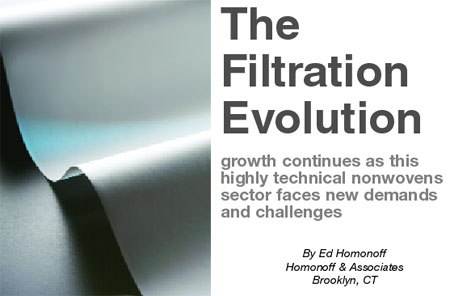
Almost all nonwovens producers are looking for new markets
for expansion. One of the key factors they are looking at is the growth of
any target market. If a market is growing, it makes it attractive to
penetrate with new products. The filtration market is definitely growing
and continues to draw strong interest from nonwovens producers and raw
material suppliers. The filtration business is viewed as offering many
opportunities for companies to penetrate into new applications or
geographies with both existing and new products.
“The filtration
business is growing in part because of the demand for cleaner air and
cleaner water. Meeting these demands makes our environment a better place
for us all to live, and filtration is a major reason for it,” said Gary
Blevins, vice president of sales and marketing for Ahlstrom Filtration
North America. In fact, many segments of the filtration business are
growing at multiples of inflation that far exceed the businesses they
serve. Water filtration, power generation and diesel exhaust are all
filtration market segments that are growing at rates significantly greater
than the rate of inflation.
When nonwovens companies look at the
filtration business, they must first consider what its characteristics are
and how they fit them before they decide to enter the business. Some of
these characteristics are:
?? filtration is a technical
business
?? filtration is highly fragmented
?? razor/razor blade
business model
?? outside influences have a large impact on its
direction.
Technical Business
“In the old days…” is a statement not heard much anymore in filtration. There have been many new technical developments during the past few decades that have changed the character of this business and those who have chosen to compete in it. Filtration applications have become much more demanding and customers have become significantly more knowledgeable about the products they produce and sell. Gone are the days when a customer would specify a filter medium by basis weight and permeability alone. Today, roll goods filter media are purchased to very exacting performance standards defined under specialized test conditions. Nonwovens companies that enter this business must be able to speak the language of filtration and have a high level of sophistication that gives their customers a great degree of comfort.
Fragmentation
There is no such thing as one filter medium that works in all filter applications. Some filter media are designed for single use and others must perform under repeated cleaning conditions. Filter media are challenged with many types of fluids (both air and liquid), must remove a broad range of contaminant types from fluid streams (including solid and liquid contaminants) and must work across a great many processes and conditions (including variations in temperature, operating pressures and chemical resistances). The applications are usually so different from one another that, while many companies participate in the filtration business, they may not compete directly against each other. In fact, two of the largest filtration companies in North America, one focused on air and one on liquid, have very little overlap in their product portfolios and do not compete against each other in most of their markets. As we all know, a filter medium suited for a building ventilation filter (HVAC) will not work in coal-fired power plant bag houses and will not work in a polymer filter. Yet, these are all filters and all use nonwoven media.
Razor/Razor Blade Model
One of the most attractive characteristics of the
filtration business to nonwoven roll goods producers is that a very high
percentage of filters are produced for single-use applications and have
finite useful lives. In many cases, the purpose of a filter in a process
or a piece of capital equipment is to protect the machinery or purify a
product by removing an unwanted component from a fluid stream. When one of
these filters gets dirty, the filter can no longer clean, protect and
purify like it was designed to for that specific application, requiring a
filter change.
Many maintenance programs have been developed to
systematically and regularly replace filters based on either time in use,
pressure drop rise or quantity of product produced. This is a good thing
for filter makers and their suppliers as it drives replacement filter
sales and increases consumption of filter media roll goods. Just like a
dull razor blade, filters must be changed when they stop performing their
function, making this a good business model from the viewpoint of the
filter maker and their raw material suppliers.
Outside Influences
In the filtration world today, a large proportion of growth is being driven by factors outside of the market such as government regulations. For example, regulations that have been issued in the U.S., Europe and Japan have created a filtration revolution in the diesel engine business. Extremely tight rules worldwide for allowable emissions from diesel engines have generated new truck filtration design changes throughout the engine, starting with exhaust filters but also changing the types of engine oils required to work in the new exhaust gas recirculation systems. These oils become much more chemically aggressive during use and attack today’s commodity filter media types and have created the need for more chemical resistance in many of the filter applications that are being deployed in the engine. Many industry experts project that this business will grow to a $10-15 billion business for filter products during the next five to 10 years. Other businesses seeing the same regulatory effects include power generation, storm water and drinking water.
Growth Trends
In addition to regulatory influences, there are a number
of trends and factors impacting the direction of the filtration business.
At the macro level, finer filtration continues to be a major driver across
the board in all segments of the business. Liquid applications as
different as fuel filtration and drinking water markets are demanding more
efficient filters. The same is true in air filtration, where applications
such as HVAC and power generation are continuing to demand from more
efficient filters and, therefore, more efficient filter media roll
goods from filter producers. For example, the EPA and PM 2.5 has forced
the development of better performing felt media for use in bag houses for
power plants.
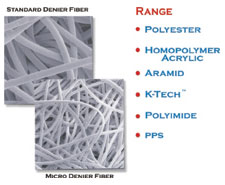 Danny Grover, president of Southern Felt, an Andrew
Group company, said that Southern Felt is introducing several new felts in
its Microfelt line for low and high temperature applications. “These felts
offer much better efficiency ratings than standard felts,” he remarked.
“In fact, filter bags and cartridges produced from these felt media have
significantly lower emissions and less particle penetration, leading to
bags that require almost 50% fewer pulse cleaning cycles to control
operating pressure build and operating cost savings of 30% compared to the
life of standard felt bags in use today.”
Danny Grover, president of Southern Felt, an Andrew
Group company, said that Southern Felt is introducing several new felts in
its Microfelt line for low and high temperature applications. “These felts
offer much better efficiency ratings than standard felts,” he remarked.
“In fact, filter bags and cartridges produced from these felt media have
significantly lower emissions and less particle penetration, leading to
bags that require almost 50% fewer pulse cleaning cycles to control
operating pressure build and operating cost savings of 30% compared to the
life of standard felt bags in use today.”
Another trend that has
accelerated over the past few years is the demand for filter media with
multiple functions. The filter media, in addition to removing particulate,
must also remove odor, taste or have specialized chemistries that are used
to neutralize chemical changes in fluids. Mr. Blevins of Ahlstrom said,
“Customers are asking for filtration media that do more than they used to.
The media may act as a carrier for materials such as baking soda to remove
odor in a room air filter or chemicals that neutralize the acidity of oils
and coolants during their use. This leads to the need for multiple layer
and composite nonwoven products such as our Trinitex brand that can form
multifunctional sheets to meet customer demands.”
Ahlstrom’s
proprietary Trinitex technology is used to form three-layer wetlaid
nonwovens with the ability to vary the composition of the inner and outer
layers. This technology finds its way into many applications. Most
notably, filtration products take advantage of it because of its ability
to customize pore size in each layer.
Storm Clouds
While the outlook for growth continues to be strong, there
are a number of clouds on the horizon in the filtration business that all
companies must be aware of. During the past year, energy prices have
skyrocketed. This has changed the way some nonwovens companies think about
making their products. Many of our industry’s products are treated or
finished to meet very demanding performance standards. Finishing processes
typically use high levels of energy to dry, cure, singe or otherwise
finish a nonwoven filter medium for shipment to the customer. Some
companies are now experimenting with accomplishing the finish step earlier
in the process by adding components during the nonwovens manufacturing
process and capturing more value by cutting out finishing steps.
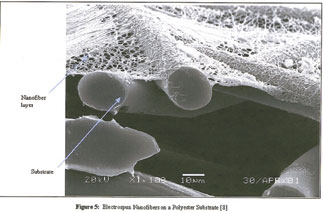 Another cloud on the horizon has been shortage of
supply for certain fiber and polymer types. Demand has outpaced supply in
a number of performance markets. Mr. Grover stated that “due to shortages
of name brand high temperature fibers over the past year, Southern Felt
Company has had to source generic fibers either from domestic sources or
other countries such as China. We are now offering a line of high
temperature felts that we call generic blends. By offering these felts, we
have been able to keep our customers supplied and at competitive pricing.”
And, as we all know, the supply situation has been exacerbated by the
production disruption and force majeure of a number of chemical feed stock
producers in the U.S. due to the hurricanes that damaged the Southeastern
U.S. earlier this summer.
Another cloud on the horizon has been shortage of
supply for certain fiber and polymer types. Demand has outpaced supply in
a number of performance markets. Mr. Grover stated that “due to shortages
of name brand high temperature fibers over the past year, Southern Felt
Company has had to source generic fibers either from domestic sources or
other countries such as China. We are now offering a line of high
temperature felts that we call generic blends. By offering these felts, we
have been able to keep our customers supplied and at competitive pricing.”
And, as we all know, the supply situation has been exacerbated by the
production disruption and force majeure of a number of chemical feed stock
producers in the U.S. due to the hurricanes that damaged the Southeastern
U.S. earlier this summer.
Another issue that has warranted much
more attention lately is the emergence of off-shore filter suppliers
bringing low cost filters into the U.S. This has already started in Asia
in two ways. First, Western companies have built plants there to take
advantage of the low labor cost base available and have started to produce
product for domestic consumption as well as for export to developed
countries to combat margin compaction. Secondly, Asian companies have
started to build filters for both domestic and export consumption.
Shipping nonwoven filter media to Asia for conversion into filters tends
not to be cost competitive for many media types. This puts pressure on
prices of Western filter media as the available market size shrinks at
home as the customer moves overseas.
Finally, technological changes
have and will continue to impact the filter media business and determine
who the winners and losers supplying nonwoven filter media will be in the
long run. Older technologies such as drylaid nonwovens have become either
relegated to low-end performance applications or made obsolete altogether
by newer technologies like nanofibers and composites. In the HVAC
business, producers of synthetic nonwoven filter media have taken share
from drylaid/latex bonded products. Will nanofiber web composites do the
same tomorrow to today’s synthetics? Nanofibers are one of the most
talked-about technologies impacting filtration today as can be seen by the
actions of two of the biggest filter media players in the market, Ahlstrom
and Hollingsworth & Vose. They both offer nanofiber nonwoven filter
media solutions for a number of filtration applications today, and some of
us believe that this is only the tip of the iceberg as to where these
products will be tomorrow.
Where Do We Go from Here?
One of the beauties of our business is that filtration is
always needed. This means that filtration markets, while they may change
and look different in the future, will in most cases still be there and
most likely will still be growing, again good news for nonwovens filter
media suppliers. Governments continue to regulate emissions of air and
liquid pollutants, manufacturers continue to demand cleaner and purer
products and people expect better lifestyles for themselves and their
children both in developed and emerging economies around the world.
Companies that meet these demands in the filtration business will prosper
for the long term. Many major nonwoven filter media producers have
invested in other geographies to capture the growth in many of these
economies. One example is Southern Felt, which has completed its expansion
in China. The new state-of-the-art plant will also make filtration its
main focus. “The new plant will be able to produce all synthetic fiber
types including microdenier fibers,” commented Mr. Grover.
In five
years, the pace of change in the filtration business will increase again.
Customers will enjoy the application of new technologies to the filtration
business to make better filter media products cost effectively. Many
companies are investing today in these technologies so that they have more
technology “tools” in their “toolboxes.” These nonwoven roll goods
producers have expanded their technology base to be able to supply
nonwoven filter media with increased value in many of the markets they
participate in today and want to be part of tomorrow.
According to
Ahlstrom’s Mr. Blevins, “Customers will continue to demand better
solutions to tighter product requirements. This trend will require a broad
spectrum of new products and technologies needed to meet these needs. In
fact, we believe that this trend may stretch the definition of “fiber
solutions” as we look at our business over the next five years.” So with
the filtration business continuing to prepare itself for growth with new
products and in new geographic regions, it is easy to see why new
companies will be testing the waters for entry. It is a robust and dynamic
business today and all things point to this continuing into the
foreseeable future.

